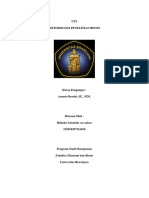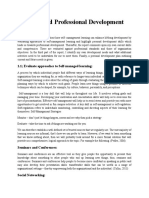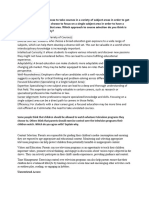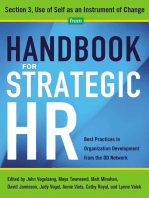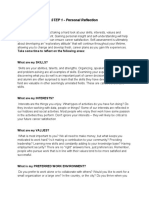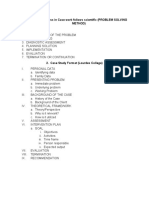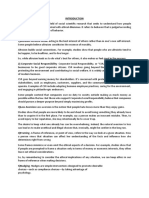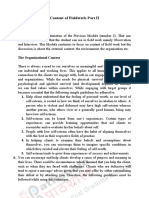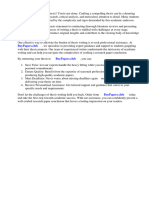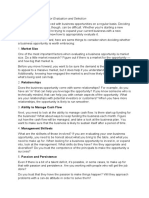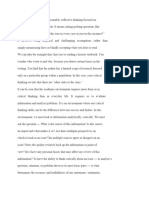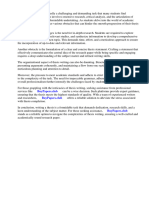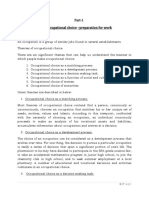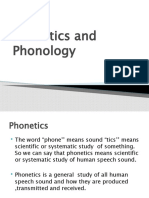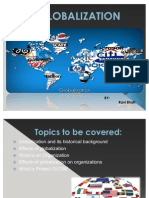Professional Documents
Culture Documents
L01 Planned Happenstance
L01 Planned Happenstance
Uploaded by
dannybmc12Original Description:
Copyright
Available Formats
Share this document
Did you find this document useful?
Is this content inappropriate?
Report this DocumentCopyright:
Available Formats
L01 Planned Happenstance
L01 Planned Happenstance
Uploaded by
dannybmc12Copyright:
Available Formats
Planned Happenstance in Action: Helping clients to navigate the unpredictable
Centre for Guidance Studies Seminar Friday 12th October 2007
This seminar examined emerging application of the theory of Planned Happenstance,
within career education and guidance contexts.
What influences career decision making?
If we look back over our career and education history it is not hard to see that chance
impacts on our decision making. There can be many reasons for this: geography or
location, what other people decide/do –e.g. partners, family, friends, the people our
networks connect us with, and who we are introduced to through our networks. The
labour market, government policy changes, trends/fashion, organisational change, and
team deficits can all influence our decisions.
These factors influence our choices in a very different way to the more traditional trait
and factor based rational career decision making model. In the latter, one takes the
test, gets assessed, and matched with a job which requires the skills, aptitudes and
interests which we have scored highest on. The trait and factor approach helps us
make sense of the world of work, but its critics say that personality is much more
complex than this, and impossible to second guess.
Trait and factor is still very much seen as the dominant model in careers guidance.
(This link outlines the main points of the trait and factor theoretical approach
http://www.guidance-research.org/EG/impprac/ImpP2/traditional/matching/ )
However, in some areas, new models are being built around narrative (story telling)
approaches to careers education and guidance, as well as greater awareness of chance
and its role in decision making. Derby University is working closely with Careers
Scotland to develop just such new models.
Social Learning Theory
The ‘Planned Happenstance’ theory has evolved, in part, from the social learning
theory of career decision making developed by Krumboltz. This in turn derived from
Bandura’s Social Learning Theory. Krumboltz proposed that there were a set of 4 main
influences on career choice: Genetic (i.e. race/gender); Environmental factors – such
as social, cultural and economic factors; Learning experience to date; Task Approach
Skills (i.e. is the person skilled in problem definition, generation of alternatives,
gathering and assessment of information?) This set of factors affects our world view,
and influences our actions as we consider learning and career development decisions.
Krumboltz and others have developed the social learning theory further. Key points of
the theory are that:
Our goal in IAG is not just about decisions, but about life satisfaction for clients
Reviewed August 2019
We can use tests as talking points, to get another perspective, but the focus
should not just be on a list of matching results
We should encourage our clients to experiment and take risks
We should encourage our clients to keep an open mind
The unexpected events in life can offer benefits which we should help our clients
maximize
We should encourage lifelong learning
Implications if we accept the value of planned happenstance:
IAG should be a lifelong process rather than a one off intervention
The distinction between career and personal counselling should be broken down
– life events and career are interwoven
Counseling around transition may be more appropriate than career counseling
Practitioners will need training to adopt new methods in their guidance work
More detailed exploration of the Social Learning Theory, the SLTCDM and its liks to
Planned Happenstance can be found at:
http://www.guidance-research.org/EG/impprac/ImpP2/traditional/learning-theory/
indexfolder_printall
Decision Making and Planned Happenstance
Jenny Bimrose has suggested in recent research that only 25% of people fall into the
strategic/rational decision maker category (taking sequential steps to meet
identifiable goals). This suggests that up to three quarters of clients for career guidance
might not be best served by approaches which assume the best way to make decisions
is to follow a proactive, analytical and rational decision making strategy. A further 25%
are more opportunistic – seeing what comes along at the time - and are open minded,
exploring new opportunities and testing things before committing.
Kathleen Mitchell is a key proponent of Planned Happenstance (City College, San
Francsico) having written various books including “The Unplanned Career - How to
Turn Curiosity Into Opportunity”. A workbook is also available.
More about her work and publications at: http://plannedhappenstance.com/aboutus.html
Previous theories based on accidental career choice failed to take account of the
contribution that people make – their thoughts, actions and attitudes, which are
applied to situations. These can influence how we perceive opportunities in chance
situations. It is also possible to put ourselves into situations where we will be exposed
to more chance opportunities. Activities which give rise to networking for example, will
lead to opportunities, which would otherwise pass by a person who simply sat back and
did not engage with others.
Reviewed August 2019
Practical application in guidance
There are two key things to work with clients on:
Getting them to explore more – as this generates chance opportunities
Helping people develop the skills and attitudes they need to make the best of any
opportunities that present – i.e. optimism confidence and resilience to set backs
These skills include:
Being curious
Being persistent
Flexibility – changing attitudes as circumstances change
Optimism – being open to seeing possibilities in things
Comfortable taking risks – when the outcome is far from certain
Practitioners can help clients review their personal timeline and explore how and when
chance intervened in their career and education to date.
There is also a notion that you have to have decided on your career choice before you
act – but in fact planned happenstance would suggest you should act before you
decide! This is why clients should be encouraged to become “curious explorers”.
Encouraging Curious Exploration
A key element in the theory is the idea of “curious exploration”. If we adopt the use
of planned happenstance theory with clients it changes the way we might suggest they
act. For example, instead of asking a client to visit the stands they are interested in at a
careers convention, you might deliberately ask them to visit stands they would never
normally have considered – just to see what opportunities arise, and nurture their open
mindedness. Similarly, rather than doing work experience in the thing they always
wanted to do, they should choose a totally different placement to gain new insights and
awareness. They should certainly be encouraged to explore and develop new
networks, and actively participate in them with no other goal than exposure to new
people, ideas and opportunities.
Curious exploration might include:
stepping out of one’s comfort zone
visiting convention stands you’d never have thought to visit (e.g. Plan 3 such
visits)
Talking to people
Doing voluntary work – but not necessarily related to a specific occupational area
of interest
Shadowing people
Using media – exploring occupations which appear on a TV show /film /book
Using “dream setting” or “wave a magic wand” scenarios to explore symbolic
career ideas – (not always just pure fantasy!)
Reviewed August 2019
Go to evening classes, clubs, other networks
Participate in something – expanding your sense of self and the world
Go online – use second life, join forums and meet people online
Set yourself tasks – e.g. to talk to 3 strangers at a party
Mentoring – either be a mentor or get a mentor
Change focus from “what will help me get from A to B?” to “what will help me
explore?”
Suitability for clients
Many types of client could benefit from understanding the potential of planned
happenstance:
Creative/lateral thinkers
Flexible clients who like freedom more than security
People under pressure/frozen in their decision making
Those who are uncertain – the “don’t knows”
Perfectionists – struggling for the perfect match and fearing making wrong decision
Those with complex lives – e.g. care leavers
Those without many opportunities/limited options
Entrepreneurial people
Those overwhelmed by rational decision making
Students who see decision making as a distant future activity
Pragmatists who like to try things first
Those with faith or spiritual dimension to their decision making in life – i.e. remaining
open to intervention of God’s will, fate or destiny.
People affected by ill health, redundancy etc – whose plans come apart at the seams
Mindset Categories
In 2005 DfES commissioned work on decision making – which suggested young people
fell into different mindsets. The Mindsets categorise young people as falling into one
the following groups:
Confident aspirationals – “My ambition will get me there.”
Determined realists – “I know what I want: let me focus on that.”
Long-term preparers – “School, degree, then I am not sure.”
Indecisive worriers – “How can I decide? It is all too much.”
Short-term conformists – “What is the next step in the education system?”
Unrealistic dreamers – “I am going to be a surgeon or a deep sea diver.”
Comfort seekers – “I would like a nice life.”
Defeated copers – “I will make do with what I know I can do.”
Different strategies would need to be adopted by career guidance practitioners with
each of the groups.
Reviewed August 2019
You can read a summary of the key points from Sarah Blenkinsop and Marion Morris’
work here: http://www.teachingexpertise.com/articles/making-the-right-choices-at-14-
and-16-1519 or follow the link to the full report and tool here:
http://www.dfes.gov.uk/research/data/uploadfiles/RR773.pdf
Decision Making Styles and Strategies for Intervention
Liane Hambly identifies 4 main decision making styles. She urges practitioners to
consider how a client prefers to make decisions, and to then tailor the
intervention accordingly:
Rational Intuitive approach Planned Cooperative
approach Happenstance decision maker
(chance)
approach
Looks at pros and Quick, wants to Flexible, optimistic, Seeks belonging,
cons own a decision, willingness to learn acceptance,
Wants justifiable uses own wisdom, from mistakes, decides in line with
decisions possibly biased take an open others, sees
Challenges bias minded view, take decision as a
Can lead to more risks and grasp shared
Can be time commitment to opportunities when responsibility,
consuming and action. But can they arise. draws on
ignores also be community or
subconscious manipulated by Requires network knowledge
client to reinforce confidence and
status quo. some resilience to
cope with any set
backs.
INTERVENTION INTERVENTION INTERVENTION INTERVENTION
Look at pros and Use visualisation, Networking, Involve others,
cons. what if scenarios, tasters, identify key players
What would the reaction to volunteering and influences,
criteria be for a opportunities, mind Challenge false identify wishes and
best option? mapping, games, career beliefs by needs, and areas
Use matching dreams and hopes. ‘reframing’. of tension in
approaches process
Reframing Career Myths
Reframing “Career Myths” can be a useful part of the approach using planned
happenstance. Liane Hambly suggested clients may hold mistaken beliefs (e.g. that
they should know what they want to do; that they should decide on a career path and
then stick to it; or that they are just unlucky). All of these beliefs can be rephrased – for
example you don’t have to stay on a path which makes you unhappy, that it’s fine to
keep options open and be flexible to opportunities that come your way.
Reviewed August 2019
The Problem with Choice – Too much of a Good Thing?
In his book “The Paradox of Choice”, Barry Schwartz discusses the interesting concept
that more can sometimes be less!
We assume that more choice means better options and greater satisfaction. But choice
overload can make you question the decisions you make before you even make them,
it can set you up for unrealistically high expectations, and it can make you blame
yourself for any and all failures. In the long run, this can lead to decision-making
paralysis.
For key points from Barry Schwartz on this concept see
http://www.squeezedbooks.com/book/show/19/the-paradox-of-choice-why-more-is-less
Some Questions for Career Guidance Practitioners
How far can ‘Planned Happenstance’ be applied to guidance practice with
clients?
What are its implications for the nature of the practitioner – client relationship?
What are the implications for the career guidance delivery structure?
How far would current quality assurance mechanisms continue to be
relevant/applicable in the ‘Planned Happenstance’ world of career guidance?
Michael Larbalestier
October 2007
Reviewed August 2019
You might also like
- Business Communication (1st Ed.) - Pardillo, Jonah C. (2019)Document237 pagesBusiness Communication (1st Ed.) - Pardillo, Jonah C. (2019)Phan Đỗ QuỳnhNo ratings yet
- Personal Development Module 13 Career - PathwaysDocument5 pagesPersonal Development Module 13 Career - PathwaysJ A M50% (2)
- Career Counseling Thesis PDFDocument8 pagesCareer Counseling Thesis PDFheduurief100% (2)
- MODULE 3 - Career DevelopmentDocument4 pagesMODULE 3 - Career DevelopmentKay AbawagNo ratings yet
- Entrep Mind Prelim Module 01Document24 pagesEntrep Mind Prelim Module 01romanillosroy2No ratings yet
- School Counseling Research Paper TopicsDocument8 pagesSchool Counseling Research Paper Topicsfyrc79tv100% (1)
- Research 1 5 DoneDocument41 pagesResearch 1 5 DoneChanine Fe CarmenNo ratings yet
- Project and Flipped ClassesDocument9 pagesProject and Flipped ClassesOmar ArroyoNo ratings yet
- Term Paper About Guidance and CounselingDocument4 pagesTerm Paper About Guidance and Counselingc5q1thnj100% (1)
- Q3 LCTDocument3 pagesQ3 LCTAlian KhanNo ratings yet
- Course On Social WorkDocument5 pagesCourse On Social Workpanel1bumyj3100% (2)
- Thesis On Higher Order Thinking SkillsDocument7 pagesThesis On Higher Order Thinking SkillsBrittany Brown100% (2)
- V. Ethical Dilemmas in Intercultural InteractionsDocument5 pagesV. Ethical Dilemmas in Intercultural InteractionsVheronicaNo ratings yet
- Managment AssignmentDocument5 pagesManagment AssignmentbashatigabuNo ratings yet
- Belinda Salsabila A - 20 - 225020207111036 - UTS Metodologi Penelitian BisnisDocument5 pagesBelinda Salsabila A - 20 - 225020207111036 - UTS Metodologi Penelitian BisnisAzzar NJNo ratings yet
- Career Planning 09 FinalDocument9 pagesCareer Planning 09 FinalqwertyNo ratings yet
- Personal and Professional Development: Task 1Document13 pagesPersonal and Professional Development: Task 1Abrar Khan MarwatNo ratings yet
- Critical Thinking Term Paper TopicsDocument8 pagesCritical Thinking Term Paper Topicsaflsigakf100% (1)
- Persuasive Research Paper Topics PsychologyDocument4 pagesPersuasive Research Paper Topics Psychologyafeaoebid100% (1)
- Speaking Task ReasonsDocument17 pagesSpeaking Task Reasonssedrakyan.ariannaNo ratings yet
- Prepared By: Jemna PitogoDocument33 pagesPrepared By: Jemna PitogoJemna Ursal PitogoNo ratings yet
- Handbook for Strategic HR - Section 3: Use of Self as an Instrument of ChangeFrom EverandHandbook for Strategic HR - Section 3: Use of Self as an Instrument of ChangeNo ratings yet
- STEP 1 - Personal Reflection: Self-Assessment Is About Taking A Hard Look at Your Skills, Interests, Values andDocument14 pagesSTEP 1 - Personal Reflection: Self-Assessment Is About Taking A Hard Look at Your Skills, Interests, Values andJack Monter100% (1)
- Areas of CounsellingDocument19 pagesAreas of CounsellingMuhammad Ahmad NaeemNo ratings yet
- Social Work Course SubjectsDocument8 pagesSocial Work Course Subjectsbdg9hkj6100% (2)
- Career TheoriesDocument8 pagesCareer TheoriesMaria Nita BoloNo ratings yet
- HRM Career DevelopmentDocument26 pagesHRM Career DevelopmentSuman PoudelNo ratings yet
- ch30 Aspen Ad TNDocument11 pagesch30 Aspen Ad TNKinta PutriNo ratings yet
- Career Development Thesis TopicsDocument5 pagesCareer Development Thesis Topicsjessicaspellfayetteville100% (1)
- Career Theory Holland Bandura SuperDocument13 pagesCareer Theory Holland Bandura SuperFitri Bdk Hrd100% (1)
- Final Examination Convert To Coursework - An Individual Essay QuestionsDocument21 pagesFinal Examination Convert To Coursework - An Individual Essay QuestionsNayama NayamaNo ratings yet
- Helping Process in Case WorkDocument5 pagesHelping Process in Case Workkhian renidoNo ratings yet
- Inbound 3987136638865036331Document18 pagesInbound 3987136638865036331Kareen CasaljayNo ratings yet
- Counselling Course WorkDocument7 pagesCounselling Course Workafjwdryfaveezn100% (2)
- Research Paper On Work AttitudeDocument7 pagesResearch Paper On Work Attitudefvhwd4yj100% (1)
- Thesis Psychology ExampleDocument8 pagesThesis Psychology Examplegloriamoorepeoria100% (1)
- SOCIAL STUDIES-BGCSEWPS OfficeDocument20 pagesSOCIAL STUDIES-BGCSEWPS OfficeYame Yaya MoilatshimoNo ratings yet
- Final Final ReportDocument38 pagesFinal Final Reporttrisha sinhaNo ratings yet
- Report Seven-HabitsDocument23 pagesReport Seven-HabitsFREYSSINET LYN URIARTENo ratings yet
- Decision MakingDocument9 pagesDecision MakingmaricarNo ratings yet
- Research Paper On Students MotivationDocument8 pagesResearch Paper On Students Motivationwwvmdfvkg100% (1)
- Social Work Course UnitsDocument8 pagesSocial Work Course Unitsf5d7ejd0100% (2)
- Content of Fieldwork Part IIDocument10 pagesContent of Fieldwork Part IIkhalid khanNo ratings yet
- Examples of Research Paper ConclusionsDocument6 pagesExamples of Research Paper Conclusionsfys1q18y100% (1)
- Path Toward The Right ChoiceDocument37 pagesPath Toward The Right ChoiceElean Joy Reyes-GenabiaNo ratings yet
- Guidance Modules 1-4Document14 pagesGuidance Modules 1-4ely sanNo ratings yet
- Business Opportunity 2 Research PaperDocument32 pagesBusiness Opportunity 2 Research PaperCha BrankNo ratings yet
- Career CounsellingDocument9 pagesCareer Counsellingsyed waleed shahNo ratings yet
- Critical ThinkingDocument4 pagesCritical Thinkinglenguyenvietbach2004No ratings yet
- Handout No. 5Document3 pagesHandout No. 5Yannie DelfinNo ratings yet
- Ipd Decison MakingDocument10 pagesIpd Decison Makinggarg.chhaviNo ratings yet
- Professional Ethics Research Paper TopicsDocument7 pagesProfessional Ethics Research Paper Topicsd0f1lowufam3No ratings yet
- Social Work Dissertation SamplesDocument4 pagesSocial Work Dissertation SamplesDltkCustomWritingPaperCanada100% (1)
- Occupational ChoiceDocument20 pagesOccupational ChoiceMd. Erfan Ahmed0% (1)
- 8611 Assignment 1Document17 pages8611 Assignment 1fajar khanNo ratings yet
- Action Research Paper On Student MotivationDocument6 pagesAction Research Paper On Student Motivationsacjvhbkf100% (1)
- Sample Thesis in Guidance and CounselingDocument7 pagesSample Thesis in Guidance and CounselingWriteMyEnglishPaperJackson100% (2)
- Basics of CGP - EmilyDocument27 pagesBasics of CGP - Emilysandra fuentesNo ratings yet
- The Power of Professional Closeness: A Guide to Taking a Holistic Approach to Your BusinessFrom EverandThe Power of Professional Closeness: A Guide to Taking a Holistic Approach to Your BusinessNo ratings yet
- Rational Emotive Therapy Applied To The Case of StanDocument3 pagesRational Emotive Therapy Applied To The Case of StanREMY JOY CABANNo ratings yet
- Syllabus Class4 Worksheet + Unit IIIDocument16 pagesSyllabus Class4 Worksheet + Unit IIIKaraj SadhakNo ratings yet
- Department of Education: Individual Daily Log and Accomplishment ReportDocument2 pagesDepartment of Education: Individual Daily Log and Accomplishment ReportJoelmarMondonedo100% (1)
- Senarai Semak Kandungan Asas KurikulumDocument3 pagesSenarai Semak Kandungan Asas KurikulumZubaidah Ct100% (1)
- Phonetics and PhonologyDocument22 pagesPhonetics and PhonologyQamar Khokhar0% (1)
- DLL EIM G9 - 3rd Grading Week 3Document4 pagesDLL EIM G9 - 3rd Grading Week 3Bong CareyNo ratings yet
- V.K.R, V.N.B & A.G.K College of Engineering: Explain The Two Uses of Features in Machine LearningDocument2 pagesV.K.R, V.N.B & A.G.K College of Engineering: Explain The Two Uses of Features in Machine LearningNAVYA TadisettyNo ratings yet
- Describing An Organizational ChartDocument2 pagesDescribing An Organizational Chartduranmon7469No ratings yet
- Pattern Identification Exercise. ERIC Digest.: Got It!Document15 pagesPattern Identification Exercise. ERIC Digest.: Got It!Ioana DragneNo ratings yet
- Globalization and Its Impact On OrganizationDocument15 pagesGlobalization and Its Impact On OrganizationRavi Bhati88% (17)
- An Essay On The Claims of Strong Artificial IntelligenceDocument7 pagesAn Essay On The Claims of Strong Artificial IntelligenceStefan HendrickxNo ratings yet
- Course Catalogue - International Security (PGSP11162)Document4 pagesCourse Catalogue - International Security (PGSP11162)Gudeta KebedeNo ratings yet
- Monday Tuesday Wednesday Thursday Friday: Independence DayDocument3 pagesMonday Tuesday Wednesday Thursday Friday: Independence DayRuffa Marie VilloteNo ratings yet
- Research Methods in Fashion Design, It's Compilation and Importance in Design ProcessDocument11 pagesResearch Methods in Fashion Design, It's Compilation and Importance in Design ProcessriyqNo ratings yet
- Weekly Test m1 W 2 Into ReadingDocument2 pagesWeekly Test m1 W 2 Into Readingkh aliNo ratings yet
- Career/ Future Plan: My GoalsDocument1 pageCareer/ Future Plan: My GoalsDana Isabelle100% (1)
- ParagraphsDocument4 pagesParagraphsGidena Mesfin KNo ratings yet
- Contemporary English Usage: General InformationDocument4 pagesContemporary English Usage: General InformationIsmail Sani AbdullahiNo ratings yet
- CV 2023-04-08 Hamza ESSAFIDocument1 pageCV 2023-04-08 Hamza ESSAFIHamza EssafiNo ratings yet
- CTF Class Test 2 2022 Resit - QPDocument4 pagesCTF Class Test 2 2022 Resit - QPHuzaifaNo ratings yet
- BLEPT ReviewerDocument9 pagesBLEPT ReviewerJeNo ratings yet
- Career Planning 101 (GenBI)Document19 pagesCareer Planning 101 (GenBI)josephineangelinaNo ratings yet
- Learner'S Packet (Leap: Learning Area Grade LevelDocument4 pagesLearner'S Packet (Leap: Learning Area Grade LeveljamNo ratings yet
- Journal of Business Research: Grazia Murtarelli, Anne Gregory, Stefania RomentiDocument9 pagesJournal of Business Research: Grazia Murtarelli, Anne Gregory, Stefania RomentisamarNo ratings yet
- GFPA1014 - Intro To The CourseDocument13 pagesGFPA1014 - Intro To The CourseTCNo ratings yet
- Group 2 - Infosys & TCSDocument17 pagesGroup 2 - Infosys & TCSDeepa AroraNo ratings yet
- Research Proposal Template APADocument8 pagesResearch Proposal Template APASameen FaisalNo ratings yet
- Goldilocks and The Three Bears FormDocument5 pagesGoldilocks and The Three Bears Formapi-610940178No ratings yet
- Clincal Psych Test-Taking Skills 4Document9 pagesClincal Psych Test-Taking Skills 4Daphnne SantosNo ratings yet














